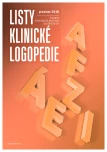Videofluoroscopy in children
Authors:
PaedDr. Bunová Barbora, PhD.
Authors‘ workplace:
Ambulancia klinickej logopédie, Koreszkova 7, 909 01 Skalica, Slovenská republika
Published in:
Listy klinické logopedie 2018; 2(2): 68-76
Category:
Miscellaneous
Overview
Dysphagia, or swallowing and feeding impairment, can occur in children from the earliest age. The etiology of these impairments is multifactorial. The incidence and prevalence of feeding and swallowing disorders in children is increasing. This is assumed to be caused by the progress in health care (e.g. the ability to save extremely premature children with a potentially higher risk of health complications in the future). The impact of dysphagia on children can be devastating from the point of view of their future development. That is why early assessment and teamwork of specialists in paediatric dysphagia, with the irreplaceable role of a SLT, is crucial. The objective of this article is to provide information on videofluoroscopic swallow study as one of the objective imaging techniques used to detect dysphagia in children.
Methodology
Videofluoroscopy in children is indicated by a medical doctor or a specifically trained speech and language therapist. The swallow study is preceded by asking in detail about family history and by a clinical examination. The indications for a clinical examination are: coughing during meal/feeding, wet or gurgly voice during and/or after meal, repeated lower respiratory tract infections and changes in vital functions during feeding (e.g. shortness of breath to apnoea, skin colour change).
Conclusion
Swallowing and feeding disorders in children are connected with long-term health consequences and can influence delays in overall psychomotor development of the child, including speech and language system development. Their early detection and subsequent “therapy” require inter- or multidisciplinary cooperation of medical and paramedical experts. These teams should be led by a speech and language therapist adequately skilled in the domain.
Keywords:
dysphagia – feeding and swallowing disorders – videofluoroscopic swallow study (VFSS) – speech and language therapist
Sources
- American College of Radiology. ACR-SPR.2017. Practice Parameter for the Performance of the Modified Barium Swallow. [cit.2018-09-28]. Dostupné z: www.acr.org
- ARVEDSON, J. C. 2016. Pediatric dysphagia: Assessment & Management of infants and children. Kurz SKIZP, Skalica.
- ARVEDSON, J. C. 2008. Assessment of Pediatric Dysphagia and Feeding Disorders: Clinical and Instrumental Approaches. In Developmental Disabilities Research Reviews, 14, 118-127.
- ARVEDSON, J. C., BRODSKY, L. 2002. Pediatric Swallowing and Feeding: assessment and management. Albany: Singular/Thompson Learning, 2nd ed.
- ARVEDSON, J. C., CLARK H., LAZARUS, C., SCHOOLING, T., FRYMARK, T. 2010. Evidence-based systematic review: Effects of oral motor interventions on feeding and swallowing in preterm infants. Am J Speech Lang Pathol, 19(4), 321-40. doi:10.1044/1058-0360.
- ARVEDSON, J. C. & LEFTON-GREIF, M. A. 1998. Pediatric videofluoroscopic swallow studies. San Antonio, TX: Communication Skill Builders. ISBN 076163228X.
- ARVEDSON, J. C., LEFTON-GREIF, M. A. 2017. Instrumental Assessment of Pediatric Dysphagia. Seminars in Speech and Language, 38, (2),135-146.
- BIBER, D. 2012. Fruhkindliche Dysphagien und Trinkschwächen. Wien: Springer-Verlag. ISBN 978-3-7091-0970-0.
- BRUNS, D. A. & THOMPSON, S. D. 2012. Feeding Chalenges in Young Children. Paul H. Brookes Publishing, Baltimore, ISBN-13: 978-1-59857-121-9.
- BRYANT-WAUGH, R., MARKHAM, L., KREIPE, R. E., WALSH, B. T. 2010. Feeding andeating disorders in childhood. Int J Eat Disord., 43, 98–111.
- DURVASULA, V. S., O’NEIL, A. C., RICHTER, G. T. 2014. Oropharyngeal dysphagia in children: mechanism, source, and management. Otolaryngol.Clin N Am. 47(5), 691–720.
- EKSTEIN, S., LANIADO, D., GLICK, B. 2010. Does picky eating affect weightfor-length measurements in young children? Clin Pediatr, 49, 217–220.
- FREY, S. 2011. Pädiatrisches Dysphagiemanagement. Munchen: Elservier GmbH. ISBN 978-3-437-48750-7.
- HENDERSON, M., MILES, A., HOLGATE, V., PERYMAN, S., ALLEN, J. 2016. Application and Verification of Quantitative Objective Videofluoroscopic Swallowing Measures in a Pediatric Population with Dysphagia. J Pediatr, 178, 200-205.
- HIORNS, M. P., RYAN, M. M. 2006. Current practice in pediatric videofluoroscopy. Pediatr Radiol, 36, 911-919.
- HUDA, W. 2009. What ER radiologists need to know about radiation risks. Emerg Radiol, 16(5), 335–341.
- ICD 11 (International Statistical Classification of Diseases and Related Health Problems) [online]. [cit. 2018-09-28]. Dostupné z: https://icd.who
- KYEONG Eun Uhm, SOOK-HEE Yi, HYUN Jung Chang, HEE Jung Cheon, JEONG-Yi Kwon. 2013. Videofluoroscopic Swallowing Study Findings in Full-Term and Preterm Infants With Dysphagia. Ann Rehabil Med, 37(2),175-182.
- LEFTON-GREIF, M. A, MCGRATTAN, K. E, CARSON, K. A., PINTO, J. M., WRIGHT, J. M., MARTIN-HARRIS, B. 2018. First Steps Towards Development of an Instrumentfor the ReproducibleQuantification of Oropharyngeal SwallowPhysiology in Bottle-Fed Children. Dysphagia, 33,76–82.
- LOGEMANN, J. A. 1983. Evaluation and Treatment of Swallowing Disorders. San Diego, CA: College Hill Press. ISBN-13: 978-0890797280.
- LOGEMANN, J. A. 1993. Manual for the videofluorographic study of swallowing: Second edition. Austin, TX., Pro-Ed, Inc.
- MARTINO, R., FOLEY, N., BHOGAL, S, DIAMANT, N., SPEECHLEY, M., TEASELL, R. 2005. Dysphagia after stroke incidence, diagnosis, and pulmonary complications. Stroke, 36(12), 2756–63.
- NEWMAN, R. D., NIGHTINGALE, J. M. 2012. Videofluoroscopy. Plural Publishing, 197-211. ISBN-13: 978-1-59756-439-7.
- ROSENBEK, J. C., ROBBINS, J. A., ROECKER, E. B., COYLE, J. L., WOOD, J. L. 1996. A penetration- aspiration scale. Dysphagia, 11, 93-98.
- SPEYER, R. 2013. Oropharyngeal dysphagia: screening and assessment. Otolaryngol Clin N Am. 46(6), 989–1008.
- Swallowing disorders (Dysphagia) in adults. In ASHA [online]. [cit. 2018-10-01]. Dostupné z: www.asha.org
- TEDLA, M. a kol. , 2018. Poruchy polykání. Tobiáš. Druhé vydanie. ISBN 978-80-7311-105.
- Team approach [online ] [cit. 2018-10-01]. Dostupné z: www.asha.org
- Zbierka zákonov, z. 87/2018 ZÁKON z 13. marca 2018, o radiačnej ochrane a o zmene a doplnení niektorých zákonov,[online]. [cit. 2018-09-02]. Dostupné z: www.noveaspi.sk
Labels
Clinical speech therapy General practitioner for children and adolescentsArticle was published in
Clinical speech therapy (Listy klinické logopedie)

2018 Issue 2
Most read in this issue
- Dostupné materiály pro terapii afázie v klinické praxi
- Acquired childhood aphasia
- Primary progressive aphasia
- Služby klientům s afázií
